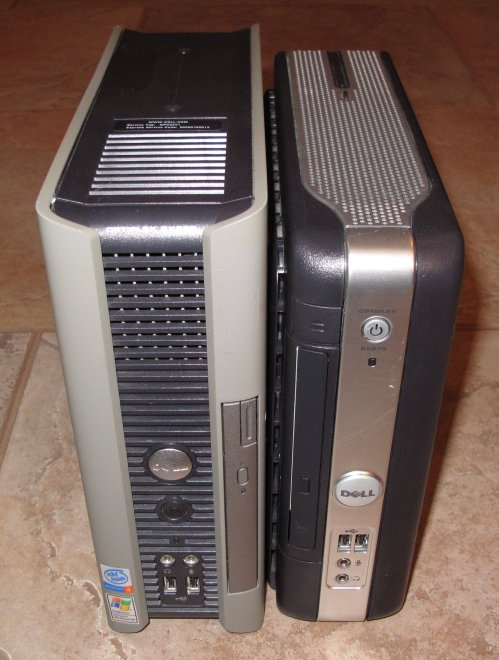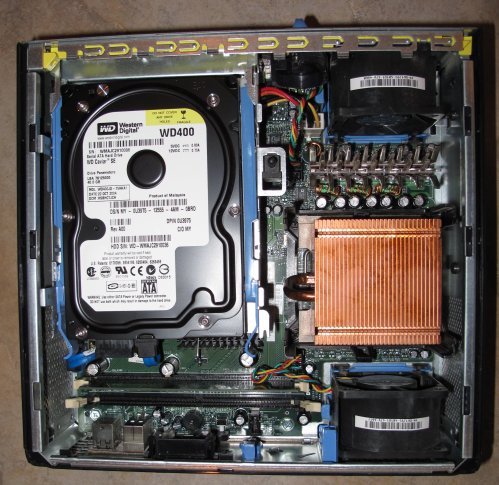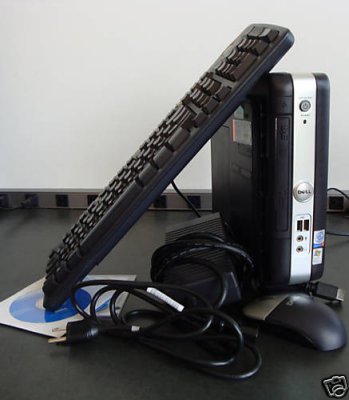 I’ve had a few days to play with the Dell SX280 Ultra Small Form Factor (USFF) PC that I bought on eBay for $90 some time back. It’s worth describing here, in case you’re looking for such a very small machine. The one I got was a 2.8 GHz Pentium 4/512 MB/40 GB system with XP Pro installed. It came with a USB keyboard and optical mouse. Both the mouse and the keyboard look brand new; the PC itself has obviously been used, but it’s quite clean and has no stickum blotches on it anywhere. I’d say a pretty good deal for $90.
I’ve had a few days to play with the Dell SX280 Ultra Small Form Factor (USFF) PC that I bought on eBay for $90 some time back. It’s worth describing here, in case you’re looking for such a very small machine. The one I got was a 2.8 GHz Pentium 4/512 MB/40 GB system with XP Pro installed. It came with a USB keyboard and optical mouse. Both the mouse and the keyboard look brand new; the PC itself has obviously been used, but it’s quite clean and has no stickum blotches on it anywhere. I’d say a pretty good deal for $90.
 The SX280 field strips very easily. The photo above shows what you’ll see under the side panel, with the bright blue plastic fan shroud removed.
The SX280 field strips very easily. The photo above shows what you’ll see under the side panel, with the bright blue plastic fan shroud removed.
Here are some points of difference, between the Dell SX270 and SX280 USFF machines:
- The SX280 is slightly larger (see photo above) and two pounds heavier. The SX270 weighs 7 pounds 5 ounces, and the SX280 9 pounds 4 ounces.
- The SX280 uses 3.5″ SATA hard drives. The SX270 uses 2.5″ ATA hard drives. 3.5″ drives are cheaper, so that’s a plus.
- The SX280 hard drive is very easy to remove. You pull the power and SATA connectors and it lifts up in a tray. The SX270 internal drive uses a more fragile ATA ribbon cable and connector system.
- The removable drive bay is a different spec. Removable drives are not interchangeable between the two systems.
- The SX270 has a reasonable internal speaker. Not hi-fi, but if you’re not listening to music it does fine for system notification sounds. The SX280 has no internal speaker at all.
- The SX270 has PS/2 connectors on the back panel for mouse and keyboard. The SX280 lacks PS/2 connectors. You need to use USB peripherals, or get a PS/2-USB adapter.
- The SX280 has 7 USB ports. The SX270 has 6. Remember that on the SX280, at least one of those must be devoted to keyboard and mouse.
- Both systems have two internal slots for memory, but the sticks are not interchangeable between SX270s and SX280s.
- Both systems have DVI video outputs only. (There’s an SX260 model, which is largely identical to the SX270, only with a VGA video connector.)
- As best I can tell, neither the SX270 nor the SX280 can be tweaked to add video modes like 1600 X 900. This was a big disappointment, since the SX280’s Intel 910GL Express chipset was supposed to allow custom resolutions, but so far, utilities like PowerStrip can’t make it work. Oddly, Linux can do 1600 X 900, but there’s a custom driver for Linux. Intel’s standard driver seems peculiarly limited. (Some think it’s a BIOS limitation; me, I’m not sure, unless Linux ignores BIOS settings.)
- Both systems have Gigabit Ethernet ports, plus DB9 serial and DB25 parallel ports.
- Both systems use external power bricks. The SX280’s is about 25% larger and runs a little hotter.
Given that the SX270 and SX280 can both be had in 3.2 GHz versions, the SX280 is a minor win, especially without the ability to tweak the graphics drivers for 16:9 widescreen modes. SATA drives and a newer Intel chipset is about all the SX280 has going for it, and if you can deal with the less vast and slightly more expensive hard drives, the SX270 is smaller and currently cheaper. The SX280 is going to the church office, and I think I’ll be sticking with the SX270 for other uses.

 I keep the tired old PCs at our church running, and I’ve decided that the church office needs something new. Or at any rate, something newer, and more compact. The church office is smaller than most bedrooms I’ve had, and yet includes two desks at which people work, plus file cabinets and many other things. Small is better.
I keep the tired old PCs at our church running, and I’ve decided that the church office needs something new. Or at any rate, something newer, and more compact. The church office is smaller than most bedrooms I’ve had, and yet includes two desks at which people work, plus file cabinets and many other things. Small is better.









